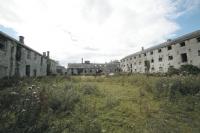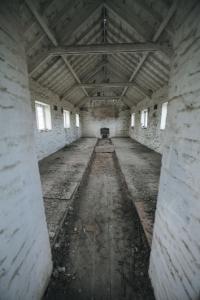Portumna workhouse, Co. Galway
Published in 18th-19th Century Social Perspectives, 18th–19th - Century History, Features, General, Issue 6 (Nov/Dec 2011), Volume 19 George Wilkinson (1814–90) was the architect responsible for Irish workhouses. Born in Oxfordshire into a family of builder-architects, he was appointed by the Irish Poor Law commissioners to design and supervise an ambitious programme of workhouse construction. He arrived in Ireland, aged 24, in 1839/40. A report for the Poor Law commissioners in 1839 stated that:
George Wilkinson (1814–90) was the architect responsible for Irish workhouses. Born in Oxfordshire into a family of builder-architects, he was appointed by the Irish Poor Law commissioners to design and supervise an ambitious programme of workhouse construction. He arrived in Ireland, aged 24, in 1839/40. A report for the Poor Law commissioners in 1839 stated that:
‘The style of the building is intended to be of the cheapest description compatible with durability; and effect is aimed at by harmony of proportion and simplicity of arrangement, all mere decoration being studiously excluded.’
Wilkinson quickly formulated a standard prototype. The first 130, completed by 1847, were built to a generic design largely from locally sourced materials. In the later phase of 33 workhouses, including Portumna, Wilkinson altered the design somewhat. Also, in response to criticism regarding damp penetration, the façades were lime-rendered and timber windows took the place of the earlier cast iron.The Portumna Poor Law union was formally declared on 22 February 1850. It was one of 33 new unions formed following the Great Famine (1845–9). It was built for 600 inmates on a site of over eight acres, for a total cost, including fittings, of £7,785. The workhouse received its first inmates in 1852. It was built on a north-west/south-east axis and was enclosed by a high stone wall. It is similar in size and layout to those at Castlecomer (1850–3; extant) and Urlingford (1851–2; demolished), Co. Kilkenny, and Clonakilty (1852–3; extant) and Mitchelstown (1850–2; demolished), Co. Cork. The complex at Portumna and its surrounding land survive largely intact, unlike many that have only survived in part or where the land attached has been used for other purposes. The buildings are laid out in a H-shaped plan, around four courtyards, with the laundry and infirmary situated to the side. All seven principal buildings survive—the boys’ and girls’ wards, the chapel and kitchen, the men’s and women’s wards, the laundry and the infirmary.Many interior features are preserved and include door fittings with ironmongery, floors, sleeping platforms and stone staircases. The dormitories show a stark design aesthetic. Limewashing was intended to prevent the spread of cholera between inmates, while the open roof structure was intended to improve air circulation. Closed for its original purpose in the early twentieth century, the workhouse has lately fallen into a state of dereliction. A conservation statement commissioned by the Western Health Board (HSE), the owners of the property, found that while the buildings were in a very vulnerable state they were not beyond repair. That report was completed in 2001. It also recommended that the removal of ivy and the restoration of the roofs be carried out as a matter of urgency.
 A local development company, South East Galway Integrated Rural Development Ltd, founded by members of the community in 1997, was interested in conserving the buildings and finding new uses for the complex. The HSE agreed to lease the complex to them and a master plan was prepared. Thus far a bat survey has been carried out; all the ivy has been removed; three roofs have been restored, with one more currently in the process of restoration; and a number of the windows have been conserved. This work has been assisted by Galway County Council, the Heritage Council, the Department of the Environment, Heritage and Local Government, Galway Rural Development Ltd and the local community. Part of the complex is now used to tell the story of the Irish workhouse. Visitors are welcome and may also enjoy seeing conservation and redevelopment work in progress. See also www.irishworkhousecentre.ie. HI Ursula Marmion is the Portumna Workhouse Project Coordinator. Series based on the National Inventory of Architectural Heritage’s ‘building of the month’, www.buildingsofireland.com.
A local development company, South East Galway Integrated Rural Development Ltd, founded by members of the community in 1997, was interested in conserving the buildings and finding new uses for the complex. The HSE agreed to lease the complex to them and a master plan was prepared. Thus far a bat survey has been carried out; all the ivy has been removed; three roofs have been restored, with one more currently in the process of restoration; and a number of the windows have been conserved. This work has been assisted by Galway County Council, the Heritage Council, the Department of the Environment, Heritage and Local Government, Galway Rural Development Ltd and the local community. Part of the complex is now used to tell the story of the Irish workhouse. Visitors are welcome and may also enjoy seeing conservation and redevelopment work in progress. See also www.irishworkhousecentre.ie. HI Ursula Marmion is the Portumna Workhouse Project Coordinator. Series based on the National Inventory of Architectural Heritage’s ‘building of the month’, www.buildingsofireland.com.
Correction: Last issue’s ‘Gem’ was credited in error to Barry O’Reilly. In fact it was written by Anna-Maria Hajba.
















